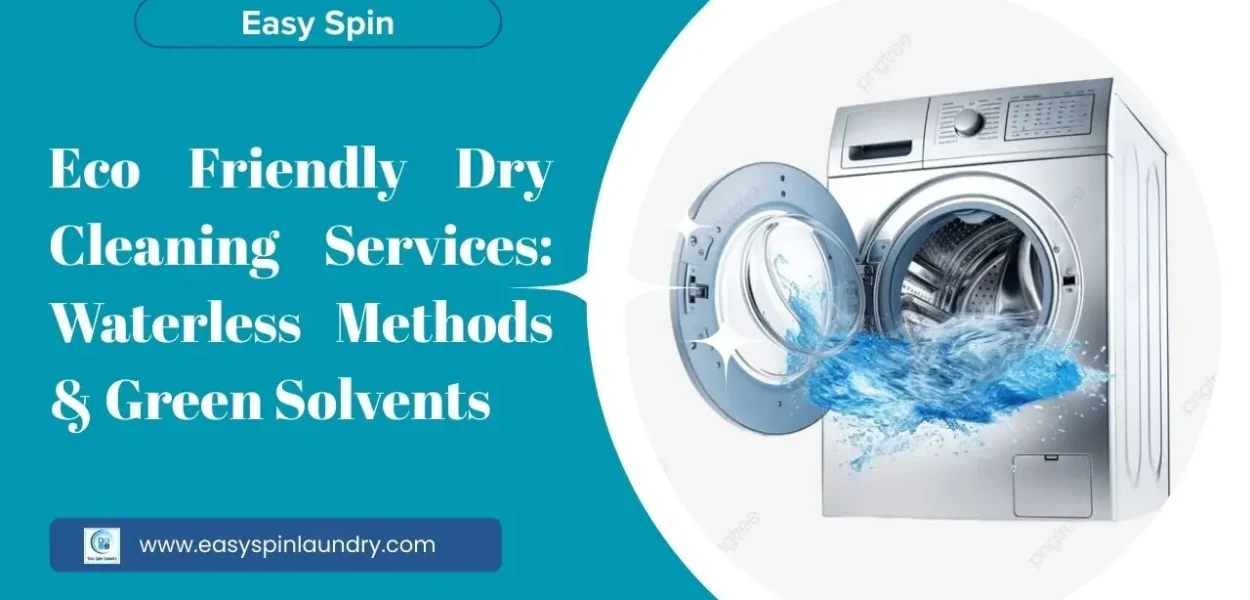Eco Friendly Dry Cleaning Services: For decades, traditional dry cleaning has been associated with harsh chemicals, especially perchloroethylene (PERC)—a solvent known for its effectiveness but also for its toxic effects on the environment and human health. As sustainability takes center stage in consumer choices, the eco-friendly dry cleaning service model has emerged as a game changer. By adopting waterless cleaning methods, biodegradable detergents, and green solvents, this innovative approach offers a safer, healthier, and more sustainable way to care for clothes.
This article explores the rise of eco-friendly dry cleaning services, focusing on how they work, the benefits they bring, and why waterless methods and green solvents are shaping the future of garment care.
What Makes a Dry Cleaning Service Eco-Friendly?
An eco-friendly dry cleaning service is built on principles of sustainability, safety, and innovation. Instead of using hazardous chemicals, these services rely on natural or biodegradable solvents, advanced machines, and waterless technologies. Their focus goes beyond stain removal—they aim to protect garments while reducing environmental footprints.
Key features include:
- Green Solvents: Plant-based, biodegradable, or liquid carbon dioxide solvents replace PERC.
- Energy Efficiency: Machines consume less electricity and heat compared to traditional equipment.
- Waterless Cleaning: Methods like liquid CO₂ or silicone-based solvents conserve water.
- Safe Disposal: Waste by-products are non-toxic and safely managed.
The Problem with Traditional Dry Cleaning
Conventional dry cleaning methods have long depended on PERC, a petroleum-based solvent that effectively removes stains. However, scientific research has shown that PERC is linked to:
- Air and groundwater contamination
- Respiratory and skin irritation
- Potential carcinogenic risks with long-term exposure
Not only is PERC harmful to the environment, but it also poses a risk to workers handling it daily. These challenges paved the way for safer alternatives—ultimately leading to the eco friendly dry cleaning service revolution.
Waterless Dry Cleaning: A Greener Approach
One of the most significant innovations in sustainable garment care is waterless dry cleaning. Instead of immersing clothes in large amounts of water or chemicals, waterless methods use specialized solvents that dissolve stains while protecting fabrics.
Benefits of Waterless Dry Cleaning:
- Preservation of Fabric Quality – Gentle solvents extend garment life.
- No Shrinking or Color Fading – Waterless methods prevent fabric distortion.
- Resource Conservation – Saves thousands of liters of water annually.
- Eco-Friendly Waste Management – Minimal hazardous waste compared to PERC cleaning.
This method is especially suitable for delicate fabrics like silk, wool, and cashmere, which often lose their texture and sheen in water-based cleaning.
Green Solvents: The Heart of Eco-Friendly Dry Cleaning
Instead of PERC, modern eco-friendly dry cleaning services rely on a variety of safe solvents. Some of the most widely used include:
1. Liquid Carbon Dioxide (CO₂) Cleaning
- Clothes are placed in a specialized machine where liquid CO₂ acts as the cleaning agent.
- Non-toxic, recyclable, and leaves no chemical odor.
- Highly effective in removing oil-based stains.
2. Silicone-Based Solvent (Decamethylcyclopentasiloxane or D5)
- Derived from sand and oxygen, making it safe and biodegradable.
- Gentle on delicate fabrics and ideal for garments with embellishments.
- Recognized for producing a soft, smooth finish without damage.
3. Plant-Based Biodegradable Solvents
- Made from renewable resources like corn, sugarcane, or soy.
- Excellent for sensitive skin and eco-conscious customers.
- Completely free from petroleum or chlorine compounds.
These solvents represent the backbone of sustainable garment care, making the eco-friendly dry cleaning service model viable for global adoption.
Comparing Eco-Friendly Dry Cleaning to Traditional Methods
| Feature | Traditional Dry Cleaning (PERC) | Eco-Friendly Dry Cleaning |
| Solvent Used | Perchloroethylene (toxic) | CO₂, Silicone, Plant-Based |
| Environmental Impact | High pollution, groundwater risk | Minimal or none |
| Fabric Safety | Harsh on delicate clothes | Gentle, long-lasting |
| Odor After Cleaning | Chemical smell | Neutral or fresh |
| Worker Safety | Health hazards | Safe for workers |
| Customer Appeal | Low awareness | High demand among eco-conscious users |
Benefits of Choosing Eco-Friendly Dry Cleaning
- Health & Safety
Customers and workers are not exposed to toxic fumes or residues. Clothes come back fresh and safe to wear. - Sustainability
Conserves water, reduces waste, and lowers carbon emissions. Eco-friendly solvents break down naturally without harming ecosystems. - Fabric Longevity
Delicate and luxury garments last longer, as green solvents are gentle compared to traditional chemicals. - Market Appeal
With increasing consumer demand for sustainable services, eco-friendly dry cleaning businesses enjoy higher trust and loyalty. - Compliance with Regulations
Many countries are phasing out PERC, making eco-friendly services the future standard.
The Rise of Eco-Friendly Dry Cleaning in India
In India, urban centers like Mumbai, Bangalore, Delhi, and Udaipur are witnessing a surge in demand for eco friendly dry cleaning services. With rising environmental awareness and a growing preference for sustainable lifestyles, consumers are actively seeking green alternatives.
Brands and local businesses are adopting app based models where customers can book pickups and deliveries, making eco-friendly garment care both convenient and accessible.
Challenges in Implementing Eco-Friendly Dry Cleaning
Despite the clear benefits, there are challenges:
- High Equipment Costs: Advanced CO₂ and silicone cleaning machines require significant investment.
- Consumer Awareness: Many still associate “dry cleaning” with strong chemical odors and don’t know about eco-friendly options.
- Training Requirements: Staff must be trained to handle green solvents and new technologies.
Overcoming these barriers requires collaboration between service providers, environmental bodies, and consumers.
Future of Eco-Friendly Dry Cleaning Services
The demand for sustainable living will only grow stronger. Future trends in eco-friendly dry cleaning include:
- Integration of AI and IoT-based machines for precision cleaning.
- Expansion of app-based booking platforms offering doorstep eco-cleaning.
- Development of new plant-based solvents that combine efficiency with cost-effectiveness.
- Mandatory phasing out of PERC-based cleaners through stricter government regulations.
As innovation continues, eco-friendly dry cleaning will no longer be a niche—it will become the new standard in garment care.
Conclusion
The shift from traditional chemical-based cleaning to eco-friendly dry cleaning services represents more than just an industry upgrade—it’s a lifestyle change. By embracing waterless methods and green solvents, we can protect our environment, safeguard human health, and extend the life of our garments.
An eco friendly dry cleaning service is not only a responsible choice for consumers but also a profitable, future-ready model for businesses. In a world where sustainability is no longer optional, green garment care is the way forward.





